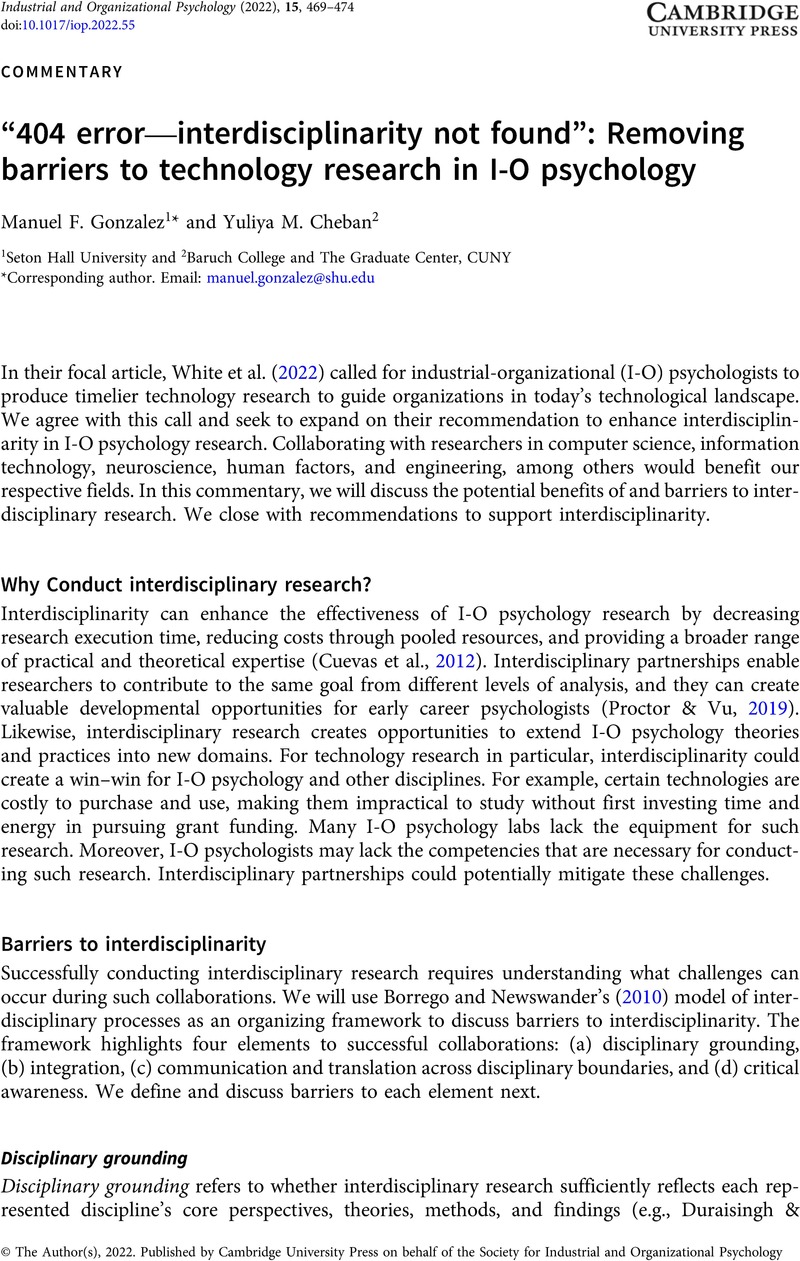No CrossRef data available.
Article contents
“404 error—interdisciplinarity not found”: Removing barriers to technology research in I-O psychology
Published online by Cambridge University Press: 09 September 2022
Abstract
An abstract is not available for this content so a preview has been provided. Please use the Get access link above for information on how to access this content.

- Type
- Commentaries
- Information
- Copyright
- © The Author(s), 2022. Published by Cambridge University Press on behalf of the Society for Industrial and Organizational Psychology
References
Borrego, M., & Newswander, L. K. (2010). Definitions of interdisciplinary research: Toward graduate-level interdisciplinary learning outcomes. Review of Higher Education, 34(1), 61–84.CrossRefGoogle Scholar
Cockburn, A., Dragicevic, P., Besançon, L., & Gutwin, C. (2020). Threats of a replication crisis in empirical computer science. Communications of the ACM, 63(8), 70–79.Google Scholar
Cuevas, H. M., Bolstad, C. A., Oberbreckling, R., LaVoie, N., Mitchell, D. K., Fielder, J., & Foltz, P. W. (2012). Benefits and challenges of multidisciplinary project teams: “Lessons learned” for researchers and practitioners. International Test and Evaluation Association Journal, 33(1), Article 108. https://commons.erau.edu/publication/108
Google Scholar
Davidson, R. J., Ekman, P., Frijda, N. H., Goldsmith, H. H., Kagan, J., Lazarus, R., Panksepp, J., Watson, D., & Clark, L. A. (1994). How are emotions distinguished from moods, temperament, and other related affective constructs? In Ekman, P. & Davidson, R. J. (Eds.), Nature of emotion: Fundamental questions (pp. 49–96). Oxford University Press.Google Scholar
Duraisingh, L. D., & Mansilla, V. B. (2007). Interdisciplinary forays within the history classroom: How the visual arts can enhance (or hinder) historical understanding. Teaching History, 129, 22–30.Google Scholar
Feldman, R. (2013). Techniques and applications for sentiment analysis. Communications of the ACM, 56(4), 82–89.CrossRefGoogle Scholar
Gonzalez, M. F., Capman, J. F., Oswald, F. L., Theys, E. R., & Tomczak, D. L. (2019). “Where’s the IO?” Artificial intelligence and machine learning in talent management systems. Personnel Assessment and Decisions, 5(3), Article 5.CrossRefGoogle Scholar
Langer, M., & Landers, R. N. (2021). The future of artificial intelligence at work: Areview on effects of decision automation and augmentation on workers targeted by algorithms and third-party observers. Computers in Human Behavior, 123, Article 106878.CrossRefGoogle Scholar
Nosek, B. A., Hardwicke, T. E., Moshontz, H., Allard, A., Corker, K. S., Dreber, A., Fidler, F., Hilgard, J., Struhl, M. K., Nuijten, M. B., Rohrer, J. M., Romero, F., Scheel, A. M., Scherer, L. D., Schönbrodt, F. D., & Vazire, S. (2022). Replicability, robustness, and reproducibility in psychological science. Annual Review of Psychology, 73, 719–748.CrossRefGoogle ScholarPubMed
Piorkowski, D., Park, S., Wang, A. Y., Wang, D., Muller, M., & Portnoy, F. (2021). How AI developers overcome communication challenges in a multidisciplinary team: Acase study. Proceedings of the ACM on Human-Computer Interaction, 5(CSCW1), 1–25.CrossRefGoogle Scholar
Proctor, R. W., & Vu, K.-P. L. (2019). How psychologists help solve real-world problems in multidisciplinary research teams: Introduction to the special issue. American Psychologist, 74(3), 271–277. https://doi.org/10.1037/amp0000458
Google ScholarPubMed
Putka, D. J., Beatty, A. S., & Reeder, M. C. (2018). Modern prediction methods: New perspectives on a common problem. Organizational Research Methods, 21(3), 689–732.CrossRefGoogle Scholar
Shaffer, J. A., DeGeest, D., & Li, A. (2016). Tackling the problem of construct proliferation: Aguide to assessing the discriminant validity of conceptually related constructs. Organizational Research Methods, 19(1), 80–110.CrossRefGoogle Scholar
White, J., Ravid, D., Siderits, I., & Behrend, T. S. (2022). An urgent call for I-O psychologists to produce timelier technology research. Industrial Organizational Psychology: Perspectives on Science and Practice, 15(3), 441–459.CrossRefGoogle Scholar




